List of cities of the ancient Near East
The earliest cities in history were in the ancient Near East, an area covering roughly that of the modern Middle East: its history began in the 4th millennium BC and ended, depending on the interpretation of the term, either with the conquest by the Achaemenid Empire in the 6th century BC or that by Alexander the Great in the 4th century BC.
| The ancient Near East |
|---|
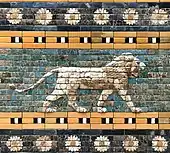 |
| Regions and states |
|
The Levant |
| Archaeological periods |
| Languages |
| Literature |
| Mythology |
| Other topics |
|
The largest cities of the Bronze Age Near East housed several tens of thousands of people. Memphis in the Early Bronze Age, with some 30,000 inhabitants, was the largest city of the time by far. Ur in the Middle Bronze Age is estimated to have had some 65,000 inhabitants; Babylon in the Late Bronze Age similarly had a population of some 50,000–60,000. Niniveh had some 20,000–30,000, reaching 100,000 only in the Iron Age (ca. 700 BC).
The KI 𒆠 determinative was the Sumerian term for a city or city state.[1] In Akkadian and Hittite orthography, URU𒌷 became a determinative sign denoting a city, or combined with KUR𒆳 "land" the kingdom or territory controlled by a city, e.g. 𒄡𒆳𒌷𒄩𒀜𒌅𒊭 LUGAL KUR URUHa-at-ti "the king of the country of (the city of) Hatti".
Mesopotamia
Lower Mesopotamia
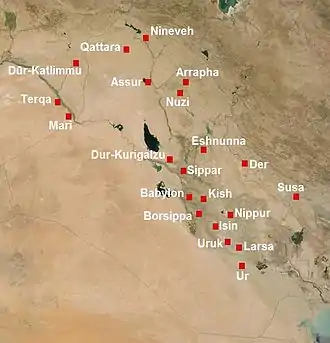
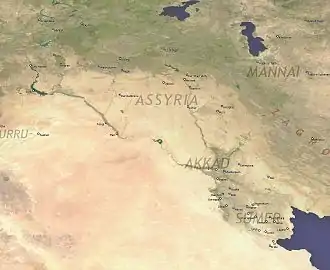
(ordered from north to south)
- Eshnunna (Tell Asmar)
- Diniktum
- Tutub (Khafajah)
- Der (Tell Aqar, Durum?)
- Sippar (Tell Abu Habbah)
- Sippar-Amnanum (Tell ed-Der)
- Urum (Tell Uqair)
- Kutha (Tell Ibrahim)
- Jemdet Nasr (NI.RU)
- Kish (Tell Uheimir & Ingharra)
- Lagaba (precise location unknown)
- Babilim (Babylon)
- Borsippa (Birs Nimrud)
- Mashkan-shapir (Tell Abu Duwari)
- Dilbat (Tell ed-Duleim)
- Nippur (Afak)
- Marad (Tell Wannat es-Sadum)
- Adab (Tell Bismaya)
- Isin (Ishan al-Bahriyat)
- Kisurra (Tell Abu Hatab)
- Shuruppak (Tell Fara)
- Bad-tibira (Tell al-Madineh?)
- Zabalam (Tell Ibzeikh)
- Umma ("Umm al-Aqarib" and Tell Jokha)
- Girsu (Tello or Telloh)
- Lagash (Tell al-Hiba)
- Uruk (Warka)
- Larsa (Tell as-Senkereh)
- Tell Khaiber
- Ur (Tell al-Muqayyar)
- Kuara (Tell al-Lahm)
- Eridu (Tell Abu Shahrain)
- Ubaid (Tell al-'Ubaid)
- Akshak
- Akkad
Upper Mesopotamia
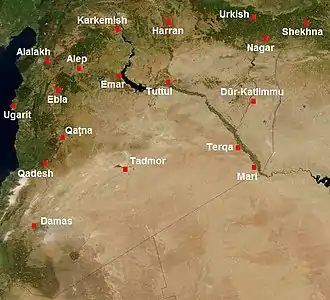
(ordered from north to south)
- Urfa
- Shanidar cave
- Urkesh (Urkish) (Tell Mozan)
- Tell Leilan (Shekhna, Shubat-Enlil)
- Tell Arbid
- Harran
- Chagar Bazar
- Mardaman (Bassetki)
- Kahat (Tell Barri)
- Tell el Fakhariya (Washukanni?)
- Hadatu (Arslan Tash)
- Carchemish (Djerabis)
- Til Barsip (Tell Ahmar)
- Tell Chuera
- Mumbaqat (Tall Munbāqa, also Ekalte (Mumbaqat))
- Al-Rawda
- Nabada l Beydar)
- Nagar (Tell Brak)
- Telul eth-Thalathat
- Tepe Gawra
- Tell Arpachiyah (Tepe Reshwa)
- Shibaniba (Tell Billa)
- Tarbisu (Sherif Khan)
- Nineveh (Ninua)
- Qatara or Karana (Tell al-Rimah)
- Tell Hamoukar
- Dur Sharrukin (Khorsabad)
- Tell Shemshara (Shusharra)
- Erbil (Urbilim, Arba-Ilu)
- Tell Taya
- Tell Hassuna
- Balawat (Imgur-Enlil)
- Tell es-Sweyhat
- Nimrud (Kalhu)
- Emar (Tell Meskene)
- Qal'at Jarmo
- Arrapha
- Kar-Tukulti-Ninurta
- Assur
- Ekallatum
- Nuzi (Yorghan Tepe, Gasur)
- Tell al-Fakhar (Kuruhanni?)
- Terqa (Tell Ashara)
- Doura Europos
- Mari (Tell Hariri)
- Haradum (Khirbet ed-Diniyeh)
- Tell es Sawwan
- Nerebtum or Kiti (Tell Ishchali)
- Tell Agrab
- Dur-Kurigalzu (Aqar Quf)
- Shaduppum (Tell Harmal)
- Seleucia
- Ctesiphon (Taq Kisra)
- Zenobia (Halabiye)
- Hatra
- Idu
Iran

- Ecbatana (Hamadan?)
- Takht-e-Suleiman
- Behistun
- Godin Tepe
- Rey (Rhages, Europos, Shahr-e-Ray, Arsacia)
- Chogha Mish
- Tepe Sialk
- Susa (Shush, Shushan)
- Kabnak (Haft Tepe)
- Dur Untash (Chogha Zanbil)
- Shahr-e-Sukhteh
- Pasargadae (Pasargad, Pasargadai)
- Naqsh-e Rustam
- Estakhr (Istakhr)
- Persepolis (Parsa)
- Tabran (Tus)
- Gabae
- Tall-i Bakun
- Izirtu
- Anshan (Tall-i Malyan or Tepe Malyan)
- Konar Sandal
- Tepe Yahya
- Teppe Hasanlu
- Bam
- Sarvestan
- Hecatompylos
- Khorramabad
- Kermanshah
- Nimvar
- Isfahan (Aspadana)
- Rabat Tepe
- Temukan
- Darabgard
- Hafshejan
- Tabriz
- Kangavar
- Shahdad
- Marlik
- Chogha Bonut
- Ganj Dareh
- Ali Kosh
- Geoy Tepe
- Baba Jan Tepe
- Shah Tepe
- Hajji Firuz Tepe
- Kul Tepe
- Shir Ashian Tepe
- Tureng Tepe
- Yarim Tepe
- Vahrkana (Gorgan)
- Narezzash (Neyriz)
- Zranka (Dahan-e Gholaman)
- Shushtar
- Shiraz
- Urmia
- Nahavand
- Patigrabana
- Bushehr
- Hormirzad (Bandar Abbas)
- Semnan
- Amol
- Karaj
- Yasuj
- Mahallat
- Arderica
- Hashtgerd
- Bit-Istar
- Liyan
- Bastam
- Ganzak
- Jiroft
- Shad Shahpour (Qazvin)
- Dezful
- Shahin (Zanjan)
- Ardabil
- Tabas
Anatolia
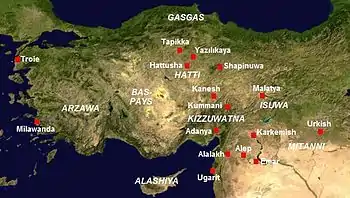
(ordered from north to south)
- İnandıktepe
- Miletus
- Sfard (Sardis)
- Nicaea
- Sapinuwa
- Yazilikaya
- Alaca Höyük
- Maşat Höyük
- Alishar Hüyük
- Hattusa
- Ilios (Wilusa, Ilion, Troas, Troy)
- Kanesh (Nesa, Kültepe)
- Arslantepe (Malatya)
- Çayönü (Amed, Diyarbakir)
- Sam'al (Zincirli Höyük)
- Çatalhöyük
- Beycesultan
- Karatepe
- Tushhan (Ziyaret Tepe)
- Adana
- Tarsus
- Zephyrion (Mersin)
- Gözlükule
- Sultantepe
- Attalia (Antalya)
The Levant
In alphabetical order:
- Acco (Acre)
- Admah (one of the five "cities of the plain")
- Adoraim (Adora, Dura)
- Afqa
- Alalah (Alalakh)
- Aleppo
- Antioch
- Aphek (Antipatris, Tell Afik)
- Arad (Arad Rabbah?; Tel Arad)
- Arqa (Arkat)
- Arwad (island off Tartus; Aradus, Arvad, Arphad, Ruad Island)
- Ashdod
- Ashkelon
- Baalbek (Heliopolis)
- Batroun (Botrys)
- Banias
- Beersheba (Tel Sheva, Tell es-Seba)
- Beth Shean (Beth Shan)
- Bet Shemesh (house of Shamash)
- Bet-el
- Bethsaida (later name of the capital of Geshur; et-Tell)
- Bethlehem
- Bezer (Bosra in Syria)
- Byblos (Gubla, Kepen)
- Dan, former Laish (Tel Dan, Tell el-Qadi)
- Damascus (Dimasqu, Dimashq)
- Deir Alla (Pethor?)
- Deir Al-Ahmar
- Dhiban (Dibon)
- Dor (D-jr, Dora)
- Ebla (Tell Mardikh)
- En Gedi, also Hazazon-tamar (Tel Goren)
- En Esur
- Enfeh (Ampi)
- Ekron (Tel Miqne, Khirbet el-Muqanna)
- Et-Tell (Ai?)
- Gath
- Gaza
- Gezer
- Gibeah (Tell el-Ful?)
- Gomorrah
- Hamath (Hama, Epiphania)
- Hazor
- Homs
- Hebron
- Hermel
- Jawa
- Jericho (Tell es-Sultan)
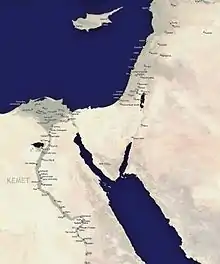
- Jerusalem (Jebus, City of David, Zion)
- Jezreel
- Kabri (one of several cities called Rehov)
- Kadesh Barnea
- Kedesh (Qadesh in Galilee)
- Khirbet Kerak (Tel Bet Yerah; later Al-Sinnabra)
- Khirbet el-Qom (Makkedah/Maqqedah)
- Khirbet Qeiyafa (Sha'arayim? / Neta'im?)
- Kir of Moab (Kerak)
- Kumidi (Kamid al lawz)
- Labweh
- Lachish (Tel Lachish, Tell ed-Duweir)
- Mari
- Majdal Anjar
- Megiddo (Tel Megiddo, Tell el-Mutesellim)
- Nagar (Tell Brak)
- Nabatieh
- Nazareth
- Qatna (Tell Mishrifeh)
- Rashaya
- Rabat Amon (Hellenistic Philadelphia)
- Rehov (Jordan Valley) (Tel Rehov)
- Samaria (Shomron)
- Sam'al
- Sarepta
- Sharuhen (Tell el-Far'ah South?, Tell el-'Ajjul?, Tel Haror?)
- Shiloh
- Sidon
- Sodom
- Tadmor (Palmyra)
- Terqa
- Tall Zira'a
- Tell Balata (Shechem)
- Tell el-Hesi (Eglon?)
- Tell Kazel
- Tell Qarqur (Karkar?)
- Tell Tweini (Gibala?)
- Tirzah (Tell el-Farah North)
- Tripoli
- Tyros (Tylos, Tyre)
- Ugarit (Ras Shamra)
- Umm el-Marra
- Tel Yokneam (Yokneam, "'En-qn'mu")
- Zeboim
- Zemar (Sumura, Sumur)
- Zoara (Zoar, Bela)
Arabian Peninsula

- Aden
- Al Ain
- Al-Ashoosh
- Awwam
- Hajar Am-Dhaybiyya
- Al-Bahah
- Barran
- Bakkah (Mecca)
- Barbar Temple
- Beihan
- Bidaa Bint Saud
- Al Bithnah
- Dahaban
- Dalma
- Al Da'asa
- Dedan (AlUla)
- Dhamar
- Dibba
- Dumat Al-Jandal (Adummatu)
- Ed-Dur
- Eudaemon
- Failaka
- Gerrha
- Ḥaram
- Hili Archaeological Park in Al Ain
- Hofuf
- Ibb
- Ibri
- Izki
- Ubar (Aram, Iram, Irum, Irem, Erum) the name of a geographic location - a city or an area, or a tribe
- Jeddah
- Jubbah, Saudi Arabia
- Julfar
- Jubail
- Kalba
- Al-Kharj
- Khaybar
- Khor Rori (Sumhuram)
- Kaminahu (Kamna)
- Lihyan
- Mada'in Saleh (Al-Hijr, el Hijr, and Hegra)
- Al Madam
- Al-Magar
- Ma'rib
- Maṣna'at Māriya
- Mleiha
- Muweilah
- Najran
- Nashan
- Nashaq
- Nizwa
- Petra
- Qatif
- Qarnawu
- Qaryat al-Faw (Dhat al-Jnan)
- Qal'at al-Bahrain
- Sakakah
- Sanaa
- Sena, Yemen
- Ṣirwāḥ
- Shabwa
- Shibam Hadramawt
- Shimal
- Sohar
- As-Subiya
- Sur, Oman
- Tabuk, Saudi Arabia
- Ta'if
- Taiz
- Tarim, Yemen
- Tayma (Tema)
- Tell Abraq
- Thaj
- Thula
- Tarout
- Timna
- Umm Al Nar
- Wadi Dawan
- Yanbu
- Yathrib (Medina)
- Zabid
- Zafar
Nubia
Egypt
See also
External links
| Wikimedia Commons has media related to Ancient cities of the Middle East. |